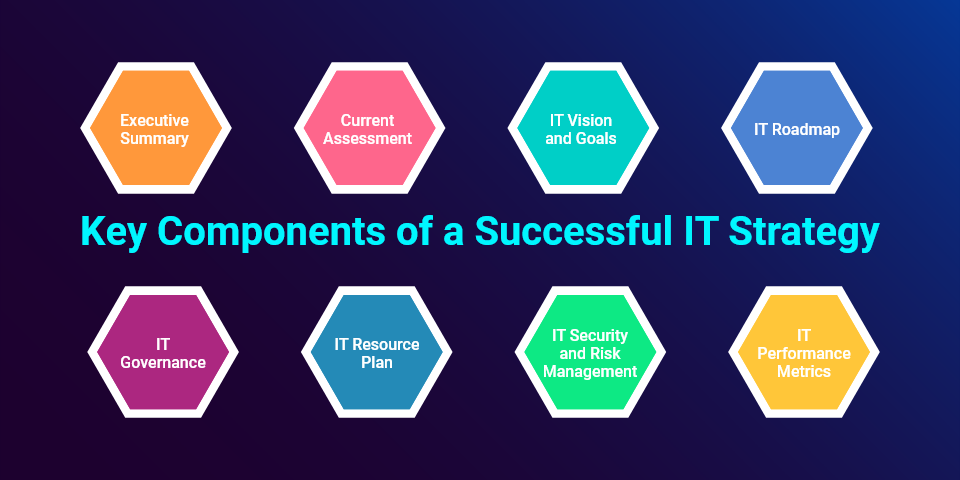An IT strategy is a plan to align the IT investments with business objectives and max out the benefits from them. An effective IT strategy can help businesses to leverage their IT infrastructure to gain competitive advantage, meet users expectations, and keep themselves uptrend with the market.
What is an IT strategy?
An IT strategy is a detailed plan of how an organization maintains and utilizes its IT systems, infrastructure, and applications. IT strategy is an important roadmap that defines how an organization invest to leverage information technology to achieve its business goals and objectives.
Key Components of a Successful IT Strategy

The components of an IT strategy plan varies from organization to organization depending on the type of organization and the work culture. Following are some key components that can be included in an IT strategic plan:
Executive Summary: Provides a brief overview of the IT planning and business objectives of the organization.
Current Assessment: Makes an SWOT analysis of the organization and builds an inventory of existing IT systems, infrastructure and processes.
IT Vision and Goals: Defines the IT mission and vision of an organization with specific goals to achieve it.
IT Roadmap: Provides a high-level outline on achieving the company’s IT goals with a well defined timeline and milestones.
IT Governance: Provides the formal framework for following IT strategy comprising leadership, structure and processes to implement IT investment in a sustainable manner.
IT Resource Plan: Outlines the budget for IT investments and a plan for acquiring resources such as personnel, hardware, software, and services.
IT Security and Risk Management: Identifies and mitigates potential IT threats and risk associated with the IT strategy.
IT Performance Metrics: Defines the performance metrics to evaluate the IT strategy implementation and benefits.
IT Strategy Planning and Implementation Types
Apart from a general IT strategy organizations may follow certain goal-based IT strategies at different stages of their growth. Specific goal-based IT strategies can be broadly categorized into:
IT Strategy for Digital Transformation
A digital transformation IT strategy sets out the roadmap for how a business transforms itself adopting new technologies. This may include adopting new digital products and services, changing existing IT architecture, and adopting state-of-the-art technologies.
IT Modernization Strategy
IT modernization strategy is similar to digital transformation strategy in adopting new services and products to change the day-to-day IT operations and processes within an organization. However, it focuses on updating the existing tech stack and restructuring the IT architecture.
Cloud-First Strategy
A cloud-first IT strategy focuses on cloud integration for almost all the IT operations in an organization. This strategy aims to shed the costs of maintaining an on-prem IT infrastructure while being able to easily scale up or down infrastructure as required.
IT Security Strategy
A security-first IT strategy focuses on detecting potential breach and mitigate risks from external threats. This strategy helps to maintain the trustworthiness of an organization. This strategy defines policies regarding access of various resources, procedures to handle data, and implementation plan of firewalls, antivirus, and encryption.
IT Framework Strategy
IT framework strategy decides the kind of product development methodology an organization will adopt to satisfy users with a good product while staying at the top of the competition. Preferably organizations adopt Agile or Lean methodologies. The strategy aims to implement a lean process, in a fast paced work environment facilitating continuous integration, testing and delivery of product.
Best Practices for Developing an IT Strategy
Implementing an IT strategy requires careful planning and assessment. Some of the best practices for developing an IT strategy are:
Define your business goals
The first step to build an IT strategy is to understand the business goals. The IT strategy must align with your business goals, serve your customers’ expectations, and maximize the benefits from your IT implementation.
Assess existing IT infrastructure
To implement an IT strategy it is important to know what are the pros and cons of existing IT infrastructure. This will require taking into account the existing hardware, software, and third party service providers. Identifying gaps in existing infrastructure will help to formulate a useful upgrade plan.
Create an Implementation Plan
Implementation is when the IT strategy goes into execution. Implementation involves deployment of hardware and software upgrades, configuring network components, and ensuring everything is tested and runs smoothly with a backup. Implementation plan guides this phase and contains the checklist to monitor progress of everything as per the plan.
Train and Support
Training the employees to be able to effectively follow the new process and policies and use the new IT infrastructure including various systems and tools is crucial to IT strategy’s success. Also a support mechanism should be instantly available to resolve issues arising during the adoption period to the new policies and processes.
Evaluate and Optimize
Creating an effective IT strategy is not a one time deal but an evolutionary task which needs to be constantly updated with changing industry needs. This is why it is important to evaluate the effectiveness of an IT strategy by taking feedback from the employees, managers and vendors and keep closing the loopholes and upgrading on the basis of that.
To sum up, the IT strategy plays a crucial role in the comprehensive strategy of an organization, empowering it to efficiently accomplish its business goals. By grasping the fundamental elements of an IT strategy, organizations can create, execute, assess, and synchronize their strategies with emerging technologies. In order to maintain competitiveness in the market, businesses must continually invest in their IT strategy, adapting to the evolving technology landscape and fostering agility and flexibility.
